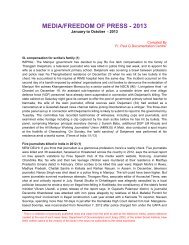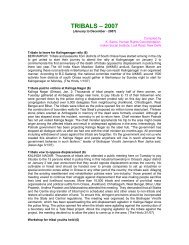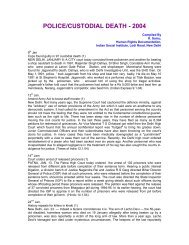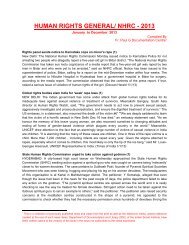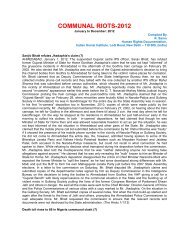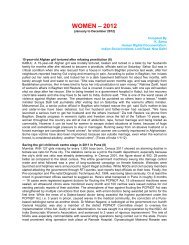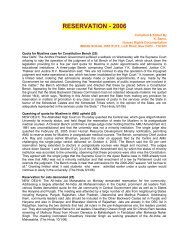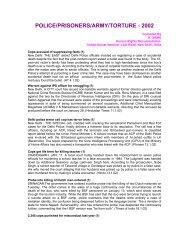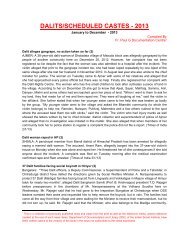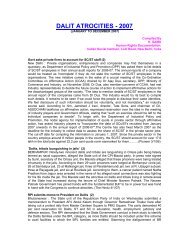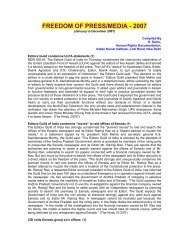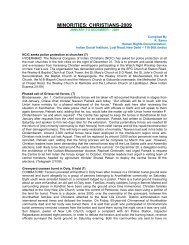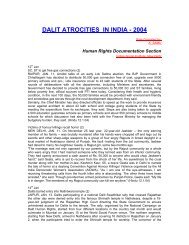NAXAL/ MAOISTS- 2009 - Indian Social Institute
NAXAL/ MAOISTS- 2009 - Indian Social Institute
NAXAL/ MAOISTS- 2009 - Indian Social Institute
Create successful ePaper yourself
Turn your PDF publications into a flip-book with our unique Google optimized e-Paper software.
Villagers flee war zone as govt battles Maoists (12)Lalgarh: Babulal Mahato hides in paddy fields each night in an eastern <strong>Indian</strong> village as security forcescarry out search operations for Maoist supporters. Along with dozens of villagers in West Bengal, 85-yearoldMahato does the same when the Maoists come to the village. "I am too old, so I hide," said Mahato,his eyes weary after spending many sleepless nights outside. "Many villagers have already left theirhomes and fled, fearing getting caught between the Maoists and police." In Lalgarh, a cluster of 150villages, daily rebel ambushes, police raids and civilians caught in the middle may be a sign of things tocome as the government prepares an offensive against Maoist insurgents. Central and state police inarmoured vehicles scour nearby jungles, a signal of the start of government's bid to stem a growingdecades-long insurgency. After a resounding general election win in May, the Congress party-ledgovernment, no longer dependent on communist parties in its coalition, has decided to take on anestimated 22,000 Maoist rebels who hold sway over swathes of countryside. Operation Green Huntreflects growing concerns that Maoists were becoming too strong after a decades-long insurgency. India'sstrong economic growth of the last few years did little to bring millions of poor villagers and tribals out ofpoverty that helps act as the backbone of Maoist support. In recent months, brazen attacks on passengertrains, attacks on mining companies and the beheading of a policeman have sparked national soulsearching. Finance minister Pranab Mukherjee has warned Maoist violence was a drain on resources.Politicians and rights activists now debate the planned offensive. Will it stem Maoist influence, or will itjust inflame tensions as villagers get caught in the crossfire? "Local people are at risk of being caught inthe middle of the fighting, killed, wounded, abducted, forced to take sides, and then risk retribution," saidMeenakshi Ganguly, senior South Asia researcher at Human Rights Watch. Six months ago, Maoists,who say they fight for poor farmers, took control of Lalgarh, a four-hour drive from east India's biggest cityof Kolkata. They drove away government staff, destroyed buildings and forced police to retreat. It was atakeover seen across hundreds of rural districts across a "red corridor" in central and eastern India. "It isnot a question of patrolling anymore. It is a question of engaging them, arresting them and killing them iffired upon," Kuldiep Singh, a senior police official in West Bengal, said. It will be a risky task. In Lalgarh,rebels are playing cat and mouse, firing at police camps in surprise attacks. "The people are with us, weare not backing out, and the government of India will learn a huge lesson if they continue their offensive,"Koteshwar Rao a.k.a. Kishenji, Maoist military commander, said in a rare telephone interview from anundisclosed location. (DNA 6/11/09)Maoists strike during Buddhadeb's visit, kill 3 (12)MIDNAPORE: Maoists struck with impunity killing three youths suspecting them to be police informersand shooting at and injuring a ruling CPI(M) leader as West Bengal Chief Minister BuddhadebBhattacharjee began a tour of the district today to take stock of the situation. Bullet-riddled bodies of threeyouths Lakhi Das, Jayram Mandi and Manoranjan, with hands and legs tied were found on a road inKusbani jungle about 70 km from here, the police said. The Maoists left behind posters claiming the threewere police spies and CPI(M) agents and had been punished. In Kolkata, Home Secretary Ardhendu Sensaid the three victims were Jharkhand Party activists. Shortly after the chief minister arrived for a reviewof the law and order and welfare measures in West Midnapore district where tribals-backed Maoist unresthas been continuing despite anti-Maoist operations by central paramilitary and state police, local CPI(M)leader Subhas Soren, was shot at, at Nandasole, about 75 km from here. Police said Soren, a member ofCPI(M)'s Gopiballavpur district committee, was accosted on the road at around 5:30 pm by suspectedMaoists who shot him below the hip. (Times of India 7/11/09)Organised Left prevented Naxals from forming base in WB: Yechury (12)New Delhi: Naxalism could not form a base in West Bengal for 30 years since its inception due to thepolitical battle waged by the organised Left, CPI(M) leader Sitaram Yechury has said."Please rememberthat Naxalbari is a village in West Bengal from where this ultra-Left (Naxal) deviation took place. And for30 years they could not come back to West Bengal only because of the fight we had put up," he toldKaran Thapar on his programme 'Devil's Advocate'. He charged the Trinamool Congress with bringingthem back, saying "they were imported into West Bengal by our political opponents ... in order to be usedagainst us." Yechury said the Trinamool Congress, which was "sitting in the Central government", wantedto fight the Left "using the Maoists and gave them shelter, gave them patronage. They were brought infrom across the border (of the state)". Defending the release of some tribal women in exchange for a



